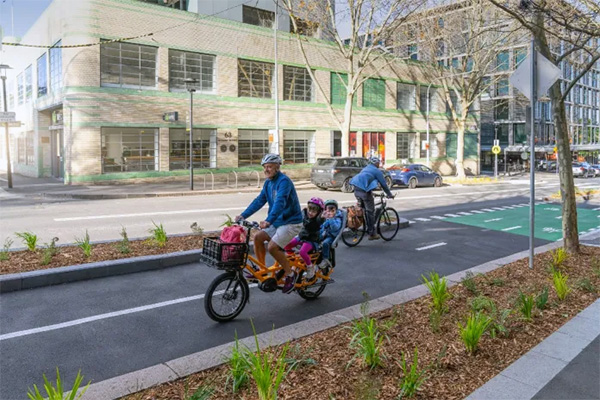10 years ago, nobody thought of Sydney as a bike-friendly city. Policy decisions ‘actively’ discouraged cycling and politicians ripped out bike infrastructure. The removal of the College Street cycleway under Minister for Roads Duncan Gay in 2015 still haunts the cycling community. Today, a new cycleway on College Street is under construction and Sydneysiders benefit from leading active transport planning and delivery. How did this cultural change happen?

The recently completed separated cycleway on Miller Street in Pyrmont not only creates a safe space to cycle but also delivered a quieter, leafier and more walkable street for everyone (Source: Sydney Civil)
The Bicycle NSW team found a recent webinar on Active Leadership for Active Transport incredibly insightful. The event was hosted by SGS Economics and Planning and featured Sara Stace, Director of Cities at WSP; Kiersten Fishburn, Deputy Secretary, Cities and Active Transport; and City of Melbourne Councillor Rohan Leppert.
It is well worth watching the recording to hear leading urban thinkers and doers discuss how state and local governments can move forward with the community to achieve progress for walking and cycling.
Some key takeaways:
- Sydney was notorious as a terrible place for cycling as recently as 2015. Since then, enormous progress has been made, underpinned by new policies that prioritise walking and cycling, and metropolitan-wide planning strategies that help dissolve council boundaries.
- Senior political leadership is very important. A dedicated Minister for Active Transport is game-changing. Such political focus ensures clear direction for those working at the front line of infrastructure and policy delivery. In addition, support for active transport is now fully bi-partisan.
- Victorian active transport advocates envy the metropolitan-wide governance in Sydney, the budget allocated to walking and cycling and, of course, our Minister for Active Transport. Although the Minister for Roads in Victoria is a passionate cyclist, he doesn’t have the same level of political clout. The excellent progress made during the pandemic feels much more precarious in Victoria.
- Data is essential to develop defensible metrics for the economic, health and environmental benefits of walking and cycling in a NSW context. However, sometimes demands for more data can stall the process of rolling out infrastructure!
- Building for active transport is not a zero-sum game. Cycleways are good for business, urban amenity, health – and driving. Advocates need to better communicate the win-win evidence.
- It is still incredibly challenging to construct cycleways in NSW and bring the community along on the journey. Direction from a dedicated ministry takes the heat out of local politics.
- Talking to the right councillor at the right time can make a huge difference in outcomes. If one decision maker understands the value of using public land for active transport rather than parking, the narrative can change quickly.
- It is very exciting to hear that the strategic cycleway corridors will be mostly planned on State roads to streamline and accelerate delivery. It will be easier for State Government to carry the pain of change as politicians and staff are further from the coal face.
Positive times for active transport in NSW! Of course, the political climate can be fickle and government priorities can change quickly. Join Bicycle NSW and support us to advocate for a better environment for bike riding throughout the peaks and troughs of politics.

